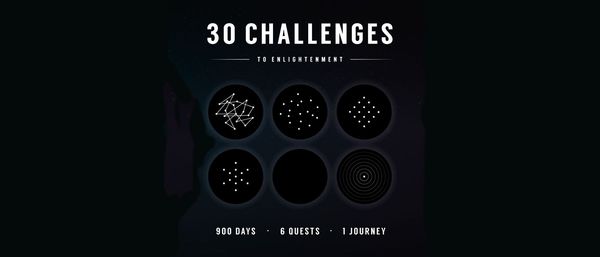Jon Brooks • • 11 min read
The Productivity Ninja Manifesto: Change Your Life One Task at a Time

That’s why some of this stuff is not a joke. We’re talking months of work—useful work—not busy work, not garbage work, but useful work done in days. At the beginning we asked the question, ‘Can you be productive to build the life you want?’ Imagine if you could move this quickly toward the thing you want to do more than anything else. That’s amazing.
— Eric Brown, How to Become a Productivity Ninja
Note from Jon Brooks: there are many so-called life changing articles on the internet, but few that truly deliver. If you follow the simple advice recommended in this article, however, what you will be able to achieve will astound you. Outlined in this piece is a complete system to change your life, one task at a time.
Who is Eric Brown?
Eric came on board the HighExistence team as an intern. He was a fan of the site, had some experience in the start up world, and was eager to do some work that was more aligned with his values.
He went in the space of 2 years, from helping out with our social media to being an indispensable member of the HighExistence core team.
Eric now manages…
- The HighExistence social media
- The HighExistence store emails
- The publishing schedule
- Apotheosis logistics and operations
- The Apotheosis integration experience
But on top of that…
Eric is a prolific writer (read here), podcaster (listen here), and video creator (watch here).
Creating transformational retreats in Costa Rica and the Netherlands where we bring together 30+ individuals from all over the world is no small feat.

Now just because someone is productive, that doesn’t mean too much to me. That’s only one half of the equation. I’m interested in personal growth and work-life balance.
And this is where Eric really shines. He doesn’t JUST get a lot of work done, across multiple projects, and quickly… he does it in a way that adds to his instead of putting it out of balance.
This is why I call Eric a Productivity Ninja. A ninja doesn’t use brute force, but instead uses strategy, tactics, and magic, to get the job done.
I recently sat down with Eric to record a 2-part video interview with him. In the first part, we discuss mindset and philosophy. And in the second part we look at the specifics of the productivity system he uses.
Think of this article as a manifesto or a cheatsheet to unlock your inner productivity ninja.
Almost 2-hours of detailed video instruction are included here as well as books, articles, concepts, and principles that should give you a complete blueprint to getting stuff done without losing your flow.
There is so much information contained in this post, that it will be worth your time to bookmark it and come back to it as much as you need.
MINDSET (I)
Watch this video:
This video is a 45-minute discussion between me and Eric on the right mindsets to achieve maximum stress-free productivity.
Listen to this podcast:
Here is a 3-hour deep dive with Eric on the interplay between leading a spiritual existence and working hard to pursue the life you want. We call it…
Integrate these principles:
1. Find your reason why you want to be productive, so you don’t fall into old habits when the going gets tough.
He who has a why to live can bear almost any how.
Friedrich Nietzsche
Being productive sounds good. Who wouldn’t want to be productive? Well… that’s actually a serious question that needs investigating.
Reflect on these questions?
- How bad do you want it?
- How bad do you need it?
- What will happen if you don’t get this area of your life handled?
- How much time will you waste?
- How much pain will you endure if you don’t optimise your productivity?
Eric makes it clear that he started getting interested in productivity because he felt he needed to. It wasn’t simply a nice hobby for him, it was essential.
This is the first step to taking the rest of the system seriously, and getting the most from it.
You need a clear reason why you want to be productive.
2. Find productive role models, who you emotionally resonate with, and study them.
There are plenty of highly productive people in the world. Some are nothing like us, some are more similar to us. When it comes to finding role models, you have to use discernment.
You have to figure out who you feel a connection with, and beyond that be realistic about what you can learn from different people.
There are some contexts, for example, where a “don’t quit” attitude might be unhelpful, and some contexts where it will be.
3. Start identifying with yourself as someone who values productivity systems and tools.
If I ask you what the Eisenhower Matrix is or the Pareto Principle, would you know?
The digital productivity ninjas I’ve met, would recognise these terms.
For them, productivity is a lifetime learning project…
And finding useful concepts that can help you get the most from your time is fun!
Here are some concepts and tools Eric suggests you understand. Google the ones that aren’t hyperlinked and see where you end up.
- Deep Work
- Maker/Manager Schedule
- 1-3-5 Technique
- Eisenhower Matrix
- Pomodoro Technique
- Eat the Frog – Mark Twain
- PEMS Energy Management (Physical, Emotional, Mental, Spiritual)
- Pareto Principle (80/20 Rule)
- Agile Framework (Scrums, Sprints, Backlogs)
- Flowstates
4. Read these books.
- Four Hour Work Week by Tim Ferriss
- So Good They Can’t Ignore You by Cal Newport
- Deep Work by Cal Newport
- Sleeping With Your Smartphone by Leslie A. Perlow
- The Lean Startup by Eric Ries
- Essentialism by Greg Mckeown
- Atomic Habits by James Clear
5. Save and read these articles.
- James Clear, Physics of Productivity: https://jamesclear.com/physics-productivity
- James Clear, First Principles: https://jamesclear.com/first-principles
- James Clear, Four Burners: https://jamesclear.com/four-burners-theory
- Asana, Work-Rest Fractal: https://wavelength.asana.com/work-life-balance/
- Asana, Pyramid of Clarity: https://wavelength.asana.com/pyramid-clarity-strategic-alignment/
- Buffer, 4 Elements of Energy: https://buffer.com/resources/the-4-elements-of-physical-energy-on-how-to-master-them
One of the main benefits we get from studying productivity from great authors is the energetic exchange that takes place. When we study productivity concepts written by someone who’s passionate and excited about productivity, it’s hard not to feel inspired.
6. Stop aiming for perfection, and instead use excellence and effectiveness as your measuring sticks for success.
The maxim ‘Nothing but perfection’ may be spelled ‘Paralysis.’
Winston Churchill
Aiming for perfection is a bad longterm strategy for success.
Life is messy. Work can be chaotic. Perfectionism holds us back from taking action, and our mental health suffers if we believe the lie that perfection even exists.
Productivity is the balance of speed and quality. Perfectionism sacrifices time for quality. Instead aim for the minimum effective dose.
What is the smallest thing you need to hit threshold level of excellence?
You could spend 10 hours on a project so that it is excellent, but to make that same project perfect could take 100 hours.
Don’t make things more complicated than they need to be. Ask yourself two simple questions:
- What is the goal?
- What are the steps to get me there?
7. A lack of intrinsic motivation cannot be overcome even with the best productivity system.
If you don’t see value in what you’re doing, no productivity system will help you. The thing that’s going to keep you productive over the years to come is intrinsic motivation.
This means you enjoy the task for its own sake. Ever wondered why some billionaires still love to work? Well the answer is that the money is not what keeps them in the game, that’s simply a feedback mechanism to let them know how well they’re doing.
We love to play games. So try and find a work game that you love to play. That doesn’t mean it can’t be challenging. In fact, challenge and frustration are important components of a great game, within reason.
If you aren’t intrinsically motivated about what you’re doing, that should trigger an alarm. Either you’re the wrong person for this task, your mindset needs to be recalibrated, or you have a mismatch between your values and your work.
8. Learn to appreciate the payoff as much as the grind.
Get rid of the utopian fantasy of entrepreneurship.
There are a lot of details. You have to file taxes, deal with complaints, and answer emails that go nowhere.
This is part of the deal. But the mistake is when you think you have to suffer the through the grind and wait to enjoy the payoff. This is actually a choice you make.
The supporting details of doing the fun stuff is what enables you to live the life you want. You can resist it and complain about it, but why not appreciate both parts.
It’s the sign of an immature person who wants the holiday without the planning. Learn to love the planning, it is part of the holiday.
If you were to only do things that you enjoy, stuff around you would fall apart and eventually you wouldn’t be able to enjoy anything.
Whenever you find yourself only enjoying one aspect of your work, zoom out and look at the big picture.
9. Become an essentialist and embark on the disciplined pursuit of less.
It actually takes discipline to NOT do things.
It takes discipline to delete those old files you no longer need; to throw out those clothes you haven’t worn in months; to empty out that big list of ideas that you’ll never have the time to execute.
When it comes to working your way through your todo list, ask important questions before you start that will cut your the nonessential.
If you’re deciding between 5 tasks, a good question to ask is…
- “Which one of these if I did it would make all of the others useless?”
10. Optimize and manage your energy levels to avoid facing uphill productivity battles.
Nature—to be commanded—must be obeyed.
Francis Bacon
The starting point for overcoming procrastination is managing your energy levels.
To begin with, you must figure out if you’re an owl or a lark.
What time of day are you most productive?
Work with that.
On top of this, how does your diet affect your energy?
Does eating a lot of carbs make you sluggish? Work with that.
Run tests and see what you find.
Procrastination is the avoidance of the energy intensive thing, so feeling like you have energy is a very important move.
Understanding how your energy levels work will give you an edge. And remember, if you happen to be in a low energy state and have to get on with stuff, there are a lot of ways you can simply change your state in minutes.
Doing 10 minutes of exercise or doing a few rounds of the Wim Hof Technique will have a big effect.
11. To beat procrastination, spend some time staring the task in the face, even if you don’t actively work on it.
If you find yourself consistently putting off the important task you know you should be doing, it’s time to take a different approach.
Here’s the ultimate hack when it comes to procrastination:
Sit down in front of the thing you want to work on and wait. Stare the task in the face for like 10 minutes, even if you don’t work on it.
Procrastination is resistance to starting not doing. So do the action that is linked with starting, and you have already beaten procrastination.
12. Show up for yourself before you show up for work.
A car cannot win a world championship race unless it is in good condition. All complicated machinery needs to be serviced before it does important work.
Before you begin work, do something to get yourself in the right headspace. Take your vitamins, do some stretching, meditate, read something inspiring. Whatever it is, take some time before you begin working for YOU.
This will keep your mind sharp and focused, and prevent you from feeling like your work life is progressing, while your self-care is regressing.
13. Create a schedule that you want to follow each day, not just in theory but in practice.
Most people think of a schedule as a dictator and they feel really bad if they don’t hit the minute to minute progression of it. So it builds a negative feeling and they stop it and it falls apart.
A schedule is framework, a scaffolding. That’s it.
Be be honest with yourself, and rest when needed. Change the schedule when needed, take a day off if needed. But don’t stop using your calendar.
Sometimes people get a crazy energy surge, and they’re left looking around not knowing what to do. This is why we have the schedule and the scaffolding.
When we create a schedule, it’s important that we be realistic with ourselves and take into account things like happiness boosters, play, and reward.
14. A productivity ninja will still be productive with a pen and paper, whereas a novice will still fail with the best productivity tools.
Technology is a tool. Tools can augment you and give you upgrades, but if you can’t wield it, it doesn’t matter.
The foundational things are inside you.
If you find yourself wanting that new productivity tool or technique thinking it will solve all of your problems, you are deluded.
Technology is incredible. A great camera can really assist a great photographer. But a truly world class photographer will be able to make stunning images even with the most archaic equipment.
Embrace your limitations.
15. Don’t modify your personality to fit someone else’s system, but change their system to fit your personality.
Elon Musk is productive, so you should copy him, right?
No.
There are always trade offs, and the trade offs Elon is making, might not be suitable for you based on your values and personality.
Certain people are programmed a certain way, and they can’t act otherwise.
Their life is a manifestation of their character.
Ever met someone who just can’t stand mess? They literally feel disgusted by clutter. Well it’s no secret that their house is clean and tidy. It’s not a secret method, it’s their personality.
To find out what kind of character you have, do Jordan B. Peterson’s personality test over at UnderstandMyself.com.
Work on your weaknesses, and play to your strengths.
16. Ask yourself, if you could be doing any work, what would you be doing?
Open a journal, and spend 20 minutes writing the answer to this question.
Do this every few months. It’s an incredibly good time investment. It will reveal things to you that you didn’t know, which will be very valuable as you play your life.
If what you answer is nothing like what you’re working on, something needs to change.
17. Your garbage follows you around, so clean up your life to enhance your abilities in work.
You bring your life to wherever you are. The garbage follows you around.
I you want to achieve maximal productivity, you have to clean up your life. Fix your relationships. Take care of your body.
It’s not enough to turn the crank of the to-do list manager.
A good place to start would be Jordan B. Peterson’s Self Authoring Writing Program.
It’s very reasonably priced, and both Eric and I have completed it. It’s profoundly valuable, and can help heal past trauma as well as help you create a step-by-step plan for the future that you can actually attain.
THE SYSTEM (II)
In the principles above, we’ve outlined the mindsets and philosophies that are essential to making any productivity system work.
Now in the video below we take a 55-minute deep dive into the exact system that Eric uses to achieve a full 9-to-5 workday in just a couple hours.
Eric walks you through how he manages his emails, folders, todo list, apps, calendar, as well as the specific productivity ninja tactics and strategies to blast through his work day.
Inside you’ll discover…
- How do to use the Pomodoro Technique the right way
- How to do the 1-3-5 system
- The modular calendar blocking method
- The declutter strategy to reduce cognitive load
- How to use your phone and notifications optimally
- And MUCH more..
There is a lot of information contained within this post.
I hope that you’ve taken away some useful tips and tricks. Refer back to it as often as you like, and be sure to subscribe to Eric’s YouTube channel here.

Jon Brooks
Jon Brooks is a Stoicism teacher and, crucially, practitioner. His Stoic meditations have accumulated thousands of listens, and he has created his own Stoic training program for modern-day Stoics.










